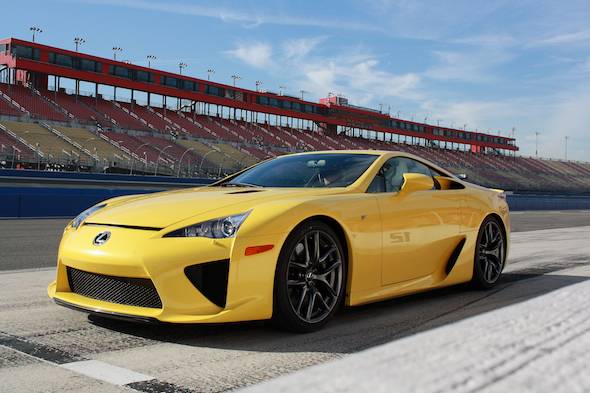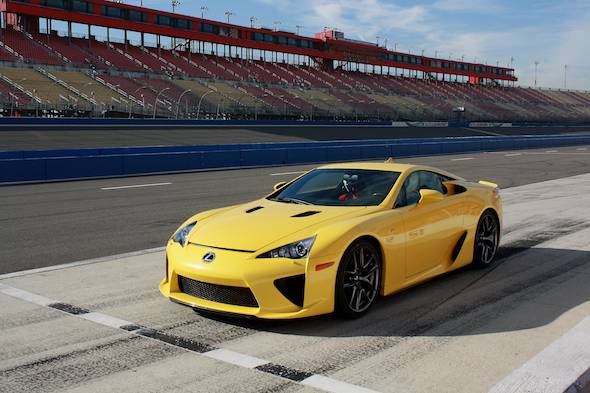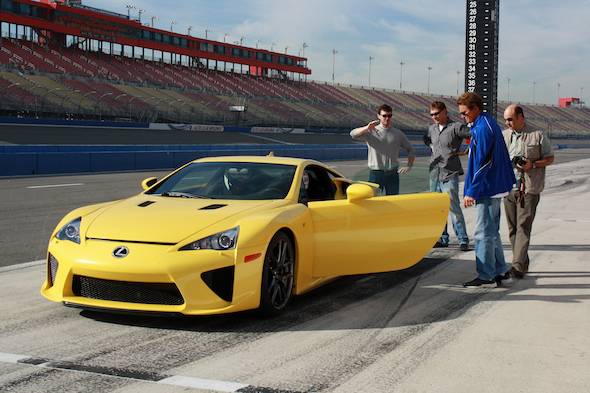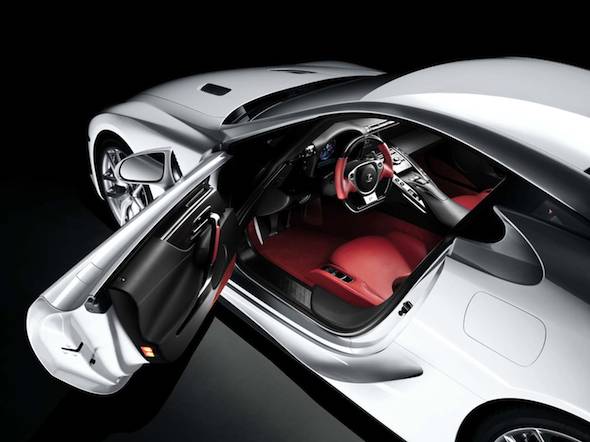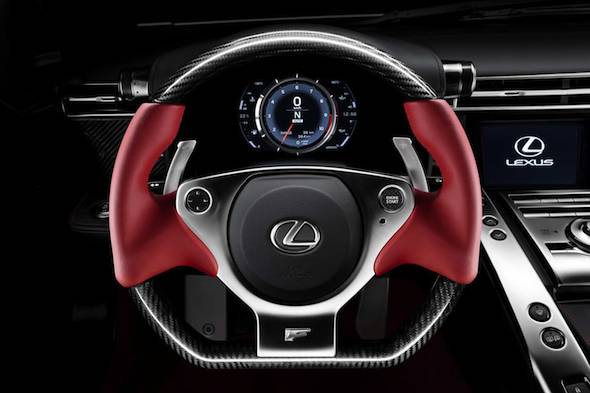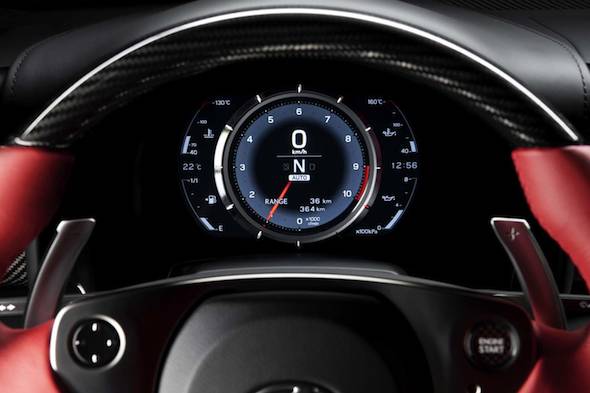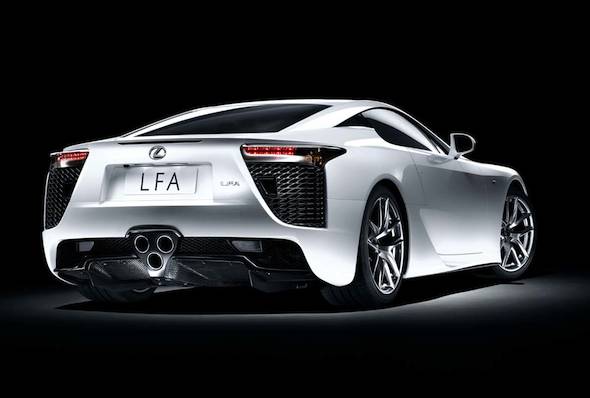When Lexus announced in mid-2007 that they would build a world class Ferrari-beater called the LFA, discerning supercar enthusiasts were rightly skeptical. After all, Toyota had not built a highline, stand-alone platform, 2-seat production sports car since the sensational 2000 GT of the late 60s. Further compounding doubt was the recent appearance of Nissan’s entrant in the category, the quick but unremarkable looking GT-R. Conventional thinking maintained that while Japanese manufacturers had the technology to produce a car fast enough to compete with Italian exotics, they lacked the sensual design language that ultimately makes those European cars so head-turning.
So naturally, when Lexus invited me and a handful of other journalists to take a few track laps in the LFA, I was eager to see if the total package would defy critics. Of course I had already seen the LFA statically displayed at major auto shows, and appearance-wise, the car does little to dispel the notion that the Japanese are incapable of penning truly breathtaking exotic car designs. With a gaggle of functional scoops and vents decorating a body that is more purposefully angular than curvaceously beautiful, the LFA is definitely a vision of tuner car muscle flexing more than one of concours-worthy elegance. But how would the intriguing car drive?
The first experiential indicator that the LFA is a seriously fast car lies not in the engine size, exhaust note, or tachometer redline, but rather in the seatbelts, which are thickly padded restraints that more closely resemble full racing harnesses than the domestic seatbelts you’ve come to love. The reason for the size, beyond the obvious, is that the belts house their own safety airbags. Not that this gave me any cause for concern. Strapping myself into the passenger seat for a preliminary passenger lap, I gave Lexus driver Scott Pruett the thumbs up to launch. As Pruett is a professional racer who co-drove the Lexus team to victory at the 2008 Rolex 24 Hours of Daytona and the 2008 Rolex Sportscar Championship, it’s safe to assume that I was in good hands.
With the upshift of a paddle, Pruett launches the rocket and I’m pinned to the back of my seat, my eager enthusiasm quickly fading to the emotional realm where shock borders fear. Lexus states that the LFA reaches 60 mph from a standstill in 3.6 seconds, but I suspect that they may be underplaying their hand. Pruett is master of his domain, of course, and as speechless as I am left by the car’s unadulterated acceleration, I’m even more shocked that he has no problem verbalizing his thoughts on the car’s performance characteristics while he demonstrates them at full tilt. Wrenching the LFA through a closed infield course at Southern California’s Auto Club Speedway, he throws the car’s full weight into a tight turn, temporarily careening me into the A-pillar in the process. As the LFA’s rear end slides out ever so slightly, he shouts above the engine roar, “See, I can put everything into the turn and the rear end barely begins to drift.” But as impressive as the defeat of lateral g-force is, I can’t help but be more absorbed by my wise decision to forego breakfast.
Pruett’s demonstration of the car’s handling is strictly limited to the infield, for when we get back out on the track, I watch the centrally located digital speedometer soar to 180 mph on the straightaways, and momentarily dip to a paltry 140 mph as he banks through the turns. When the car thankfully comes to a rest, I step out, knees wobbly and heart pounding, and receive a question from one of Pruett’s friends, who has joined us for the event.
“So,” asks Bruce Jenner, “what’d you think?” The erstwhile decathlete champion, best known today for his real-life role as the Kardashian sisters’ good-sport stepdad, raced with Pruett during the 80s and the two have remained close friends ever since. At this event, however, Jenner (pictured below in blue jacket) is just another enthusiastic car guy, trading fast car anecdotes and opinions on all matters automotive. Perhaps even more affable and at ease than his tv persona would suggest, he jokes that he might borrow the car to take home to his wife with a request to buy one, just to see how riled up she’ll get when she hears the price. Though he’s free to inquire about a place on Lexus’s waitlist, this particular car is a demo prototype, and only the second LFA in the U.S., so its sad ultimate home will more likely be a regulation-mandated spot in a car crusher rather than someone’s garage.
When I finally take the wheel of the LFA, as expected, the performance isn’t nearly as impressive as Pruett’s, though I do my best to acquit myself in front of the far superior driver. Even with just a couple laps under my belt, though, it’s clear that the high-whining 552 horsepower V-10 (which redlines at 9,200 rpm) ferociously propels the car, while the 6-speed single clutch paddle shifted transaxle smoothly adjusts engine revs for optimal downshifting and carving of road slaloms. Braking and handling are equally excellent, proving that Lexus has engineered a first rate track car, if not the world’s best looking production supercar.
As impressive as the LFA is, though, it’s difficult to understand how it logically fits into the big picture. Only 500 will be made in total, with just 170 of them coming to America. The car’s $375,000 MSRP effectively puts it out of reach of most Japanese tuner-car enthusiasts, but its unmistakable king-of-the-tuner-car looks will probably not have the concours-attending millionaires that can easily afford one lining up to do so. Interestingly, Lexus hopes to circumvent the rampant speculation and second hand dealer markup that pervades the exotic car sales niche by offering the LFA on a lease-only basis. OK, officially, it’s not a lease, but with a contract that obligates the lessee to hold on to the car for at least two years with an intent to buy, a requirement that ostensibly preserves the long term value and provenance of the car (to paraphrase Pruett’s explanation), the contract might as well be a lease.
Even at $375,000 a pop, Lexus says it will lose money on each LFA made, which might even be rationalized if the car’s technology were to be implemented in a race program or in other production cars. But as it’s unlikely that a rear-mounted transaxle or dual rear radiators will find their way into a Camry or Avalon, perhaps we should start looking for Lexus at Le Mans next June. Stay tuned…







